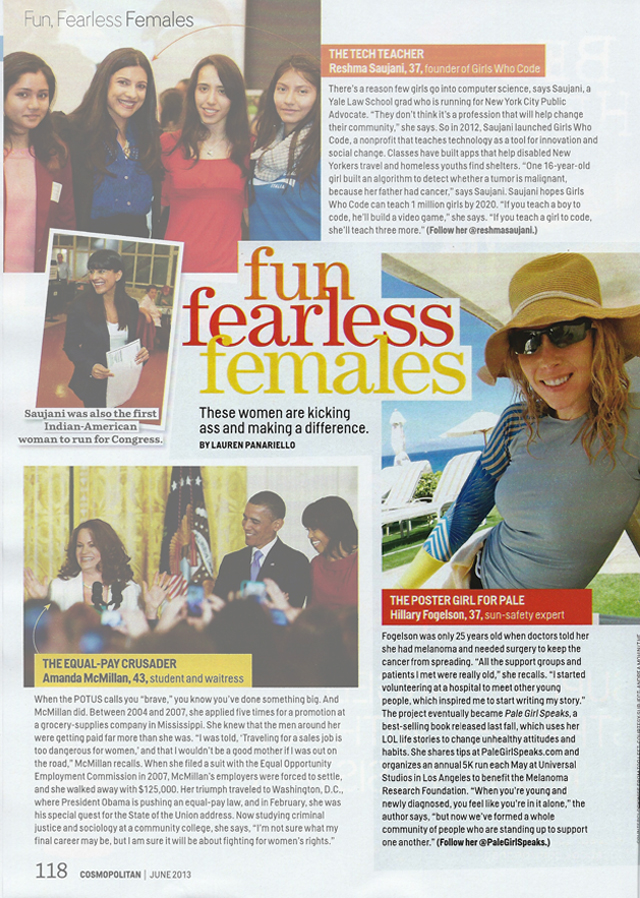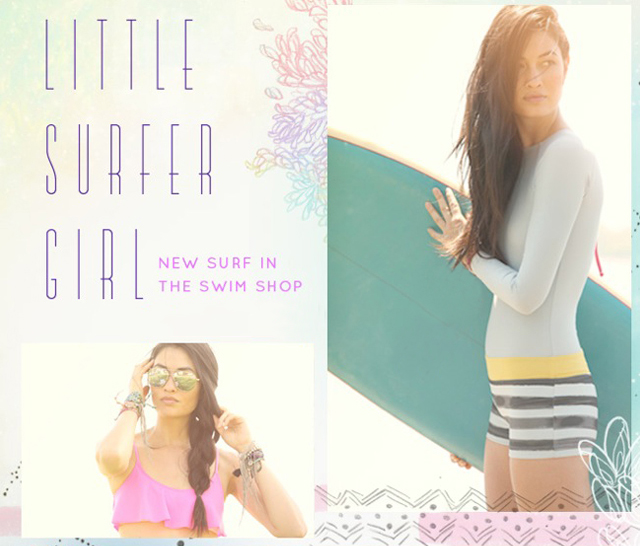
Being surfers that spend nearly every day basking in the sunshine (and its UV rays), Hillary Fogelson’s story hit home for us that no one is immune. At 25-years-old, Hillary’s dermatologist told her one of the worst things that no one ever wants to hear: She had skin cancer.
She turned lemons into lemonade with her memoir, Pale Girl Speaksthat talks about...]]>

Being surfers that spend nearly every day basking in the sunshine (and its UV rays), Hillary Fogelson’s story hit home for us that no one is immune. At 25-years-old, Hillary’s dermatologist told her one of the worst things that no one ever wants to hear: She had skin cancer.
She turned lemons into lemonade with her memoir, Pale Girl Speaks that talks about her experience overcoming melanoma in a way that’s both funny and real. Through her blog, social media and public appearances, she is a dedicated activist in educating people how to protect themselves from skin cancer.
Hillary’s ultra-fair skin is so sensitive that she has to cover up her arms and legs to make a physical barrier to the sun’s UV rays. But she didn’t let that stop her from enjoying the activities she loved, like being in the ocean, swimming in a pool, paddle-boarding and learning how to surf. When searching for more attractive rashguards online, Hillary found Seea.
“I saw what Seea was doing and I got so excited and bought a bunch of stuff. I’m so grateful that there is a cute option, instead of wearing some hideous thing,” Hillary says of the all-black, sleeved and full-legged unitard-like suit she used to wear for water activities. “I mean it allowed me to be out and doing what I wanted to do, but it wasn’t cute.”
We have all seen SPF ratings on sunscreens, which is used to rate products that you put directly on your skin. Clothing (like rashguards) is not SPF-rated, instead it is UPF-rated, which means that it is rated by the fabric’s ability to block UV rays. UPF ratings vary with each fabric, and are determined by the fabric color, weave, composition, and weight of the material.
Seea suits are made from high quality, four way stretch nylon/spandex blends. Since our rashguards usually involve at least two to three different fabrics, sometimes from different manufacturers, it is very difficult for us to issue a specific rating for each suit. For next Summer, we plan on using the same base fabric across the board, improving and unifying our ratings to 50+ UPF. To find out more about sun protective clothing, both in and out of the water, check out this article in Wikipedia.
As a mother of two daughters, age 9 and 7, Hillary has ramped up her cause to educate moms about how they can teach their children early to adopt healthy skin care practices. We sat down with her to hear her personal story and get some skin education.
 |
| The book. |
What did it feel like when you first found out you had cancer?
When you’re 25 years old, everything seems like it’s ahead of you. You’re not thinking about being sick. The word cancer when you hear it at that age, its shocking. We just all make the assumption that, ‘I felt healthy and will live a long time’ and we realize that there’s no guarantees really.
Most people go to the doctor when there’s something wrong. It’s really worth once a year, spending the money to get checked. People are busy, but you have to make your health your priority. If you feel good, you’re healthy, you don’t think about it.
How did writing your memoir come about?
After I had surgery the first time, I was journaling. I was an actress and I was writing thinking maybe at some point I would turn it into a one-woman show. I really wanted to write it as I was going through it. I basically wrote the entire book within a year and a half of having surgery except for the very last chapter. I put it away and as I was coming upon my 10-year anniversary of having melanoma the first time, I felt like there still was a lot of misunderstanding.
People didn’t know how to protect themselves. They didn’t know how to protect their kids. Friends of mine were constantly asking me what products to use, where could I find a cute rash guard. I thought, maybe the book would be a way to start a dialogue and get a larger group of people interested and educated about this. That’s when I decided to finish it.
What information was out there, and what did you think you could tell differently?
Just with the clothing, where a lot of it wasn’t very cute, a lot of the information out there was very medical, very trite. If you’re young and you’re trying to [learn more], it just felt very daunting.
A cancer memoir is the worst category a book can be in. I think when there is a lot of humor in something, they take in the information better. I don’t think scaring people works as a way to get a change in behavior. My hope was just that it would get people thinking about their skin in a different way, taking care of it.
I’m very open and really honest in the book about everything as I was going through it, how I felt about it, the good and the bad, the whole thing. Emails I’ve gotten from people that have read the book, say ‘I care about this now because I feel like I know you.’ That’s what you want. That only comes out in just that you have to be completely open about your experience.
You said there were a lot of misunderstandings about skin cancer. What are some of those misunderstandings?
People don’t think melanoma is serious. Melanoma is very different than the other forms of skin cancer. People don’t understand that it’s something that you could die from. Most cases are caused from overexposure from the sun. It’s a cancer that for the most part, is preventable. There are very few cancers you could say that about.
Because the numbers of people getting melanoma and people dying from melanoma has continued to rise year after year I thought if there is a real change in education and people started really working to prevent it then we could have a real impact on the number of people that get it and the number of people that die from it.
What questions did you get after writing the book and talking to people about your experience?
People want to know how to be safe in the sun but they want real practical information. You have to make it simple. People come to me and say, “what sunscreen do I buy?” There’s a lot of products out there, it’s daunting. I feel like I’ve tried so much on myself, on my girls, there’s a lot of great brands and there’s a lot of brands that feel like wearing toothpaste on your skin. Just like there is a lot of sun protective clothing, but its hideous. People aren’t going to wear it.
If you target moms then they start really young. It’s a habitual thing just like brushing their teeth. They protect themselves [and put on sunscreen] before they go to school. They don’t go to the beach, park, whatever, without being protected.
What are some of the most high-risk activities?
Tanning beds are such a huge contributor. They are the worst thing. The UV rays that you get from the tanning bed are literally the rays that give you melanoma. It’s targeted, intense cancer-causing rays that you get when you go to a tanning bed. Particularly in the Midwest where they don’t get sun for a lot of the year, these girls are going to tanning beds every single day.
They’ve proven that it’s addicting. The chemicals produced in your brain when you are tanning are like same chemicals that are released when gamblers are gambling. If it’s a bad habit, you don’t want your kids to start.
What is it about tanning beds that is so alluring even if people know it might be bad for them?
I think people want to be tanned. They feel that they look thinner and better when they are tanned. I understand that. But my thing is we all need to just embrace and accept the skin that we have. You can do the spray tan, which is a safe alternative but if you are not tan, to maintain a fake tan is very difficult. If I wanted to be tanned even for a week it would be so much work to try to do that. I think you kind of have to go, 'This is what I’ve got.'
 |
| Pale Girl's daughters keep their arms covered when playing outside. |
How do you teach your own children?
I started right away with them. I wish they weren’t so sensitive to the sun because it’s hard. My older daughter’s skin is like mine and even with all that we do, she will still get pink on her face and she’s getting freckles. They look at the scars that I have and they don’t want that for themselves. The reality is its not totally foolproof because there is a genetic factor. But we’re going to be on top of it. I always say when they become teenagers and rebel they are not going to do drugs, they’re going to go and get sunburned to make me crazy! That would kill me. I’d be like ‘No! You go smoke some pot and you will not go to a tanning booth!”
Sometimes it’s a pain in the ass, but sometimes I say look, you are my daughters and we are all in this together and you have to represent the cause and you have to set a good example for your friends. Your friends aren’t going to do it if you aren’t doing it. A lot of their friends have really changed how they view sunscreen and their parents have been talking to them about it.
 |
| Hillary shared a special Top 5 Must-Haves for Seea. |
]]>


